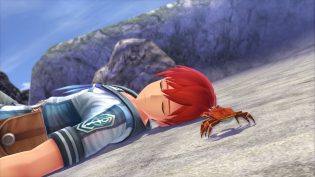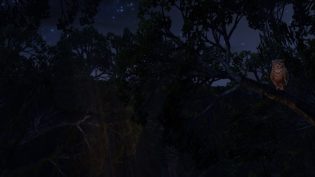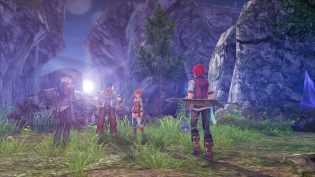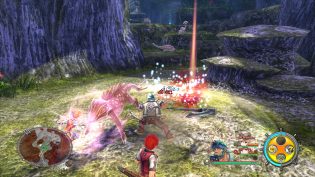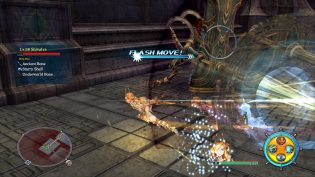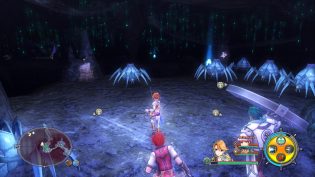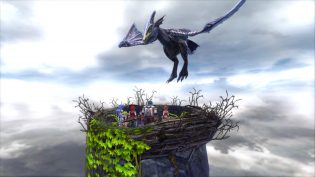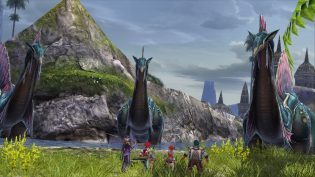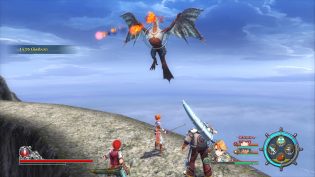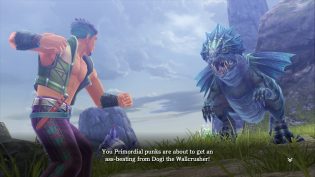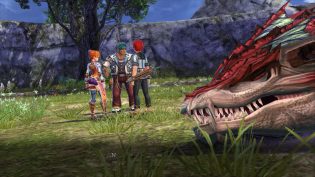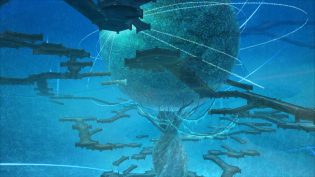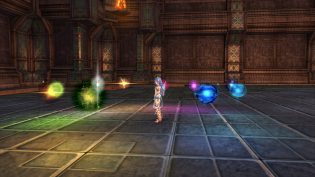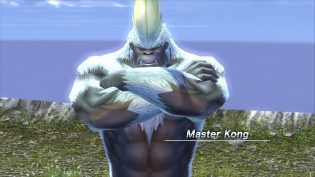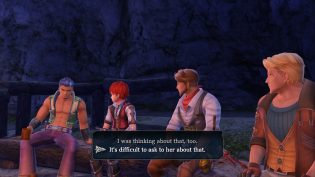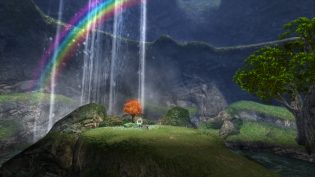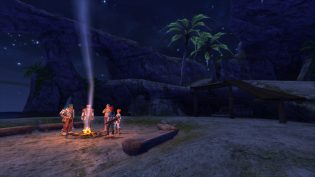In just 4 years I went from “What’s Ys?” to being a huge fan of these action RPG series by Nihon Falcom that is finally starting to get proper recognition outside of Japan. I didn’t like all games I’ve played so far equally. Origin and the story arc it preludes (covered in I & II) used to be my favorite – it had the perfect version of the gameplay mechanics that the series had in mid-00s, it had really interesting memorable story with good characters and it was quite short and to the point, covering every important and exciting aspect of itself in the best possible way. And I wasn’t super keen on the new gameplay ideas introduced in Ys Seven, the template currently used by the series, so I was a bit cautious about VIII (and still is about IV, which I will play later this year when it’s ported to PC).
Now, some of my concerns and fears were justified. But Ys VIII: Lacrimosa of DANA might be my favorite Ys game so far and one of the best examples of action RPGs I’ve ever seen, both mechanically and narratively.
Now you don’t really need to know anything from this paragraph if you want to play VIII, but, since you might’ve gotten a bit confused about me mentioning IV above, let me clarify a bit about the timeline of Ys releases and the story chronology in the quickest way possible, since it’s a bit complicated. Anyway – Ys 1-5 were all released until mid-90s on 8-bit and 16-bit systems, with 4 having 2 completely different versions with different storylines made by different developers and not Falcom themselves. After that, there has been quite a pause until the series were revisited by mid-00s with VI, which has established a template for future games to come, which included a remake of the 3rd game (now called The Oath in Felghana) and prequel to the entire series storyline – Origin. By late 00s the developers went on to establish a new gameplay template with Seven and then also reuse it for one remake (IV: Memories of Celceta, which is now the canon 4th entry of the series) and this game – Ys VIII: Lacrimosa of DANA. Which makes V the only game in the series to both never get an official release outside of Japan, despite a PS2 remake made after the developers revisited the series with VI, yet not using the template… And to make things even more confusing, the story chronology of the games is not following the numbers of releases. Currently it looks like this: Origin, I, II, IV, III (Felghana), V, VIII, VI, Seven. So, while as I’ve mentioned, you don’t need to know any of this to enjoy VIII, you will be missing some references if you haven’t played previous games, since there are a few returning characters and the starting sword is, actually, the best sword from V. Which hasn’t been localized, so even I had to look it up… Anyway, moving on.
As with the rest of the series (with the exception of Origin, set hundreds of years prior), you are playing as Adol Christin – a young self-proclaimed “adventurer” living in a world that resembles real history during the age of exploration, but with addition of a lot of myths and legends from different areas of the world proving to actually be true. As such, each game, with the exception of Origin, I and II, follows its own, mostly disconnected from other games, story, focused on a new area based on some legendary place on Earth. Even the title of the series, and the main focus of the opening games, is based on the Breton legend about a lost ancient city (also known as Kêr-Is), just with more adventure and anime. So, every new game is more like a new adventure with a familiar character in a familiar world, kind of like what you will see in some adventure book series, or something like The Witcher short stories.
Besides, the story was never really that amazing in the games after the introduction games and, thus, not the focus… That is, until now. And I am shocked to say, but Ys VIII is an actually well-made well-written exciting adventure story with memorable characters and smart varied narrative. It borrows from other sources in smart ways, surprising you with unexpected twists and layers to the story and manages to get you invested in both the grand story and all the little stories of the NPCs you help. It works this well, possibly, due to the story setup – the idea of a shipwreck and being stranded on an island, trying to build a functional society with other survivors and finding a way to escape, which helps you get invested in what you are doing and seeing the results of your work manifest in how the little village of castaways grows and evolves with time. To the point where when the ending hits, you will probably not want to leave the island. Oh and, since this is Ys, of course there are also ancient cities involved, also dinosaurs and even a bit of time shifting narration that is done surprisingly well. Sure, some people wear questionable outfits, things might become a bit “too anime” at times, but I haven’t been so invested in a story in a an action RPG game since… well, The Witcher 3, I suppose. And while I can’t really directly compare these games, I sometimes wondered if CD Projekt RED were Japanese, would their adventure action RPG game be that different from Ys VIII…
But the action RPGs are about the gameplay, right? And I wasn’t too hot on the template of Ys Seven, as I’ve mentioned, that is used in this game. Well, it’s improved a lot in Ys VIII. It essentially combines all the best ideas from the previous template (Felghana – Origin) and the one introduced in Seven to produce one of the most fun combat and exploration systems I’ve ever experienced. Seven removed the jumping and made things slower? Things are crazy fast and more vertical again. Platforming happens not particularly often and isn’t demanding, but it’s incredibly fun to pull off some crazy moves to get some things earlier than the game wants you to (but still allows this path breaking). While the combat itself just feels so much better and more fluid and responsive. In addition to Flash Guards (perfectly blocking enemy attacks) the game also has Flash Moves, which work like Platinum Games’ slow-mo dodges, triggered by dodging at the last moment, and slowing down all enemies around you. Oh and these can be combined and chained in really crazy and fun ways and I highly suggest you learn how to pull them off early to make combat more fun and so you don’t feel like you need to grind.
Because unless you really want all the achievements and all the stuff, you don’t really need to grind either, even with resources, which was a bit frustrating in Seven. It’s still a bit annoying if you are trying to get as much stuff as possible in your first playthrough, but let me tell you some good news – game has a really awesome New Game + mechanic, where you can transfer everything (or nothing, it’s actually highly customizable) to your new game playthrough and even change the difficulty for the next playthrough. So for best experience, you can strive to do all quests and do everything that is required and obvious, but you can avoid doing absolutely everything, getting all upgrades and items or doing all raids and hunts, and…
Oh yeah, there is a thing I need to criticize, though it’s rarely required for the story. The Raids and Hunts system. Now, it’s probably here because the game was initially on a portable system, so people could go in, play a raid/hunt and close the game again, but it’s not a particularly fun mechanic. Essentially, you can (and sometimes must) partake in special wave-based arenas, fighting off monsters who are trying to get in your village. Other NPCs you’ve found and helped provide background help, you can have upgrades installed to make things easier and there are some really cool ideas and mechanics in there. But I personally found it boring. And my completionist nature pushed me to go through all of them, which wasn’t super fun. So, unless you are asked to play a raid, you don’t really need to and in the end of the game you can skip all of the optional raids that become available for you, since those won’t really give you any interesting story bits. Good concept and cool ideas, but Ys is usually fun when you’re going somewhere so arenas are just too tedious in my opinion.
Luckily, the main new feature from Seven – damage types, – is less tedious to work with this time. The damage type is still tied to a character and you can switch between one of the 3 characters in your active party at will and while it’s not quite Platinum Games type of fluidity and responsiveness, Ys VIII feels much more fun and considerably less annoying with this than Seven was. It usually makes enemies more interesting due to this, rather than more annoying, and also introduces some cool ideas later in the story to spice things up, so I thought this was really well done.
And not particularly important for the main attraction of the series – the boss fights. While having both Flash move and Flash guard, in addition to a more lenient concept with healing items, can make a lot of bosses easier than what you might’ve experienced in the previous games, but as a person who actually had troubles with some of the earlier boss fights, while still appreciating their mechanics, I’m glad Ys VIII found a perfect middle ground, where on Normal difficulty you will probably not have any huge problems as long as you master the game mechanics and don’t avoid all enemies, but won’t need to grind or suddenly hit a difficulty wall. And if you want to have a more difficult game, you can always select a higher difficulty – there are plenty to choose from.
The most surprising thing to me was that Ys VIII took me about 40 hours to complete – that’s twice as long as Seven and about 3-4 times longer than older games. And yet, despite usually preferring shorter games, I never felt like the game was extending its time for no reason. There was no real padding, with only optional areas having little story, but even there – they were either very short, or full of really cool puzzles and fights. At the end of my playthrough I just went into new game plus immediately and only after a few more hours managed to pry myself from the game, because I do want to play other games after all. This effect was absolutely shocking to me, as while I liked previous Ys games a lot, none of them had kept me so captivated, invested and excited as this one.
…while I was playing it on the PC… You might’ve heard about the PC port and localisation issues already and I need to address that. The localisation has been fixed and is currently very good, when it works – I have encountered several instances where the text would display something wrong, repeat itself or have a typo, though almost all of that happened in the very last parts of the game and the game is still receiving updates. The PC port is… okay now, at least for me. It did still crash a few times. And it does seem to be having internal resolution rendering issues to this day, since I’ve seen some softer image and jaggies, often seen when the game is rendered at a lower internal resolution, though given the art style it wasn’t distracting whatsoever. That said, some people are still experiencing more severe issues, patches are still coming and for a game to be postponed for half a year and still be released in this weak state is shocking, especially given how well previous Ys games ran. So, be aware that PC version might not be the best choice, at least at the moment, and PS4 or Vita versions might be preferable.
With all this said, I still feel like I could be talking about Ys VIII for hours – that’s how excited I am about it. It’s an amazing example of an action RPG with good adventure story and really tight and fun gameplay that I would highly recommend playing. I sincerely hope that this will be the game that will get the series the recognition it deserves and even if you are not particularly interested in other games in the series, Ys VIII: Lacrimosa of DANA is the game to play.
P.S. Oh and while it’s usually expected for an Ys game (or any Falcom game) to have amazing soundtrack, Ys VIII might have the best music in a very long time, possibly even being as good as the soundtrack to the original games made by Yuzo Koshiro.


